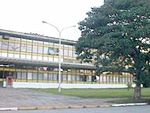The Institute of Physics of the University of São Paulo (Portuguese: Instituto de Física da Universidade de São Paulo), also known as IFUSP, is the largest and oldest physics research and teaching institution in Brazil. It is a public higher education unit located on the Armando de Salles Oliveira University City, in São Paulo. Created in 1970, it is the result of the combination of the Physics departments of the Polytechnic School of the University of São Paulo and of the former Faculty of Philosophy, Sciences and Languages.In 2021, the Institute had 388 postgraduate students (163 master's, 176 doctoral and 49 special) and 1,112 undergraduate students enrolled in the second semester (630 bachelor's and 482 undergraduate). Its administrative team includes 118 teaching staff and 257 technical-administrative staff. In 2007, according to the Brazilian Physical Society (SBF), IFUSP contributed more than 40% of national research in physics, playing a leading role in teaching, research and the development of extension activities and programs in the area.Its architectural complex includes more than 20 buildings that house classrooms, auditoriums, teaching and research laboratories, workshops and administration offices. The built-up area totals 40,000 m2, out of a total floor space of 80,000 m2. The site also has a restaurant, popularly known as "Bandejão", which provides meals for students from the university and abroad, as long as they are registered and authorized in advance to eat there. Like all of the university's departments, IFUSP is maintained by the transfer of funds from the São Paulo State Treasury. It also receives subsidies from various funding agencies, such as CNPq, FINEP, CAPES and FAPESP, with which it maintains experimental laboratories in nuclear physics, detectors and instrumentation, solid-state and low-temperature physics, plasma physics, crystallography, optics, molecular beam epitaxy, electron microscopy, biophysics, air pollution, materials analysis by ion beams, and more.Initially created in 1934 as a unit of the Faculty of Philosophy, Sciences and Languages of the University of São Paulo (FFCL-USP) by the physicist Gleb Wataghin, the institute was established in December 1969 through an academic reform that approved the foundation of several divisions within the university. In the early 1970s, IFUSP was inaugurated with three departments: Nuclear Physics, Materials Physics and Mechanics, and General and Experimental Physics, which represented the main research topics at the time.












